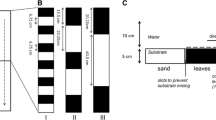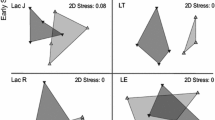Abstract
Semiarid scrubland communities are highly dynamic in terms of their species composition, abundance, and functioning, given the drastic changes in climate among seasons. Spatiotemporal patterns of saprophagous Copestylum (Diptera: Syrphidae) communities in different cactus species richness have not yet been studied, although seasonal changes and plant species richness have been shown to strongly impact the diversity and distribution of many insect communities in scrublands. We analyzed the impact of seasonality and of habitat type (disturbed and undisturbed) on Copestylum communities reared from cactus species at the Barranca de Metztitlán Biosphere Reserve, in central Mexico, by comparing their community structure between seasons and habitats, and assessing the contribution of diversity components for the total diversity of this genus. We also measured patterns of temporal niche overlap among hoverfly species considering their breeding medium. Seasonal variation influenced Copestylum community composition most significantly. Species richness and abundance of Copestylum were higher in the rainy season. Additive partitioning of diversity showed that the main component for species richness is beta diversity between seasons. We detected high niche overlap during the dry season and low overlap during the rainy season. This study provides evidence of temporal shifts in xeric hoverfly communities and suggests that the Copestylum species partition resources over time.






Similar content being viewed by others
References
Case TJ, Gilpin ME (1974) Interference competition and niche theory. Proc Natl Acad Sci USA 71:3073–3077
Clarke KR, Gorley RN (2001) PRIMER v5: user manual/tutorial. Plymouth Marine Laboratory. Primer-E Ltd., Plymouth
Cody ML, Diamond JM (1975) Ecology and evolution of communities. Harvard University Press, Cambridge
Colwell RK (2006) Estimates: statistical estimation of species richness and shared species from samples. V. 7.5. Department of Ecology and Evolutionary Biology, University of Connecticut, Storrs. http://viceroy.eeb.uconn.edu/estimates
CONABIO (2009) Capital natural de México, vol II: estado de conservación y tendencias de cambio. Comisión Nacional para el Uso y Conservación de la Biodiversidad. http://www.conabio.gob.mx
CONANP (2003) Programa de Manejo Reserva de la Biosfera Barranca de Metztitlán. In: Secretaría del Medio Ambiente y Recursos Naturales (Eds). Comisión Nacional de Áreas Naturales Protegidas México, DF
Crist TO, Veech JA, Summerville KS, Gering JC (2003) Partitioning species diversity across landscapes and regions: a hierarchical analysis of alpha, beta and gamma diversity. Am Nat 162:734–743
Feinsinger P, Spears EE, Poole RW (1981) A simple measure of niche breadth. Ecology 62:27–32
Fogleman JC, Starmer W, Heed W (1981) Larval selectivity for yeast species by Drosophila mojavensis in natural substrates. Proc Natl Acad Sci 78:4435–4439
Gibson CA, Nobel PS (1990) The cactus primer. Harvard University Press, London
Gotelli NJ, Ellison AM (2002) Assembly rules for New England ant assemblages. Oikos 99:591–599
Gotelli NJ, Entsminger GL (1999) Ecosim: null models software for ecology, version 7. Acquired Intelligence Inc and Kesey-Bear, Burlington. http://homepages.together.net/
Henderson PA, Seaby RMH (2002) Species diversity and richness 3.2. Pisces Conservation, Lymington
Hood GM (2009) PopTools version 3.1.0. http://www.cse.csiro.au/poptools
Hunt D (1999) CITES Cactaceae Checklist. Royal Botanic Gardens Kew/International Organization for Succulent Plant Study, Kew
Lande R (1996) Statistics and partitioning of species diversity, and similarity among multiple communities. Oikos 76:5–13
Legendre P, Legendre L (1998) Numerical ecology, 2nd edn. Elsevier Science, Amsterdam
Letón E, Pedromingo A (2004) G-Stat. GlaxoSmithKline, Madrid
Loreau M (1989) On testing temporal niche differentiation in cyclic environments. Oecologia 81:89–96
MacArthur RH (1958) Population ecology of some warblers of northeastern coniferous forests. Ecology 39:599–619
Magurran A (2004) Measuring biological diversity. Blackwell, London, p 179
Magurran A, Philip DAT (2001) Implications of species loss in freshwater fish assemblages. Ecography 24:645–650
Marcos-García MA, Pérez-Bañón C (2001) Immature stages of Copestylum tamaulipanum and Copestylum lentum (Diptera: Syrphidae). Eur J Entomol 98:375–385
Marcos-García MA, Pérez-Bañón C (2002) Life cycle, adult and immature stages of a new species of Copestylum (Diptera: Syrphidae) from Mexico reared from Cactaceae. Ann Entomol Soc Am 95:432–440
Martínez-Falcón AP, Marcos-García MA, Moreno CE (2008) Diversity of Copestylum (Diptera: Syrphidae) associated to decaying cactus in a shrub forest with cattle grazing management. In: Estrada EG, Equihua A, Padilla JR, Mendoza A (eds) Entomologia Mexicana, vol 7. Colegio de la Frontera Sur, México, pp 176–181
Moreno CE, Sánchez Rojas G, Verdú JR, Numa C, Marcos-García MA, Martínez Falcón AP, Galante E, Halffter G (2007) Biodiversidad en ambientes agropecuarios semiáridos en la Reserva de la Biosfera barranca de Metztitlán, México. In: Halffter G, Guevara S, Melic A (eds) Hacia una cultura de conservación de la diversidad biológica. Monografías Tercer Milenio, Spain
Noy-Meir I (1985) Desert ecosystems structure and function. In: Everani M, Goodall DW (eds) Hot desert and arid scrublands. Ecosystems of the world. Elsevier, Amsterdam
Pavon N, Briones O (2001) Phenological patterns of nine perennial plants in an intertropical semi-arid Mexican scrub. J Arid Environ 49:265–277
Rojas P, Fragoso C (2000) Composition, diversity and distribution of a Chihuahuan Desert and community (Mapimí, México). J Arid Environ 44:213–227
Rotheray GE (1993) Colour guide to hoverfly larvae (Diptera, Syrphidae) in Britain and Europe. Dipter Dig 9:1–156
Rotheray GE, Hancock EG, Marcos-García MA (2007) Neotropical Copestylum (Diptera, Syrphidae) breeding in bromeliads (Bromeliaceae) including 22 new species. Zool J Linn Soc 150:267–317
Rotheray GE, Marcos-García MA, Hancock G, Pérez-Bañón C, Maier CT (2009) Neotropical Copestylum (Diptera, Syrphidae) breeding in Agavaceae and Cactaceae including seven new species. Zool J Linn Soc 156:697–749
Schoener TW (1974) Resource partitioning in ecological communities. Science 185:27–39
Shuri JB (2007) How is diversity related to species turnover through time. Oikos 116:957
Starmer WT, Fogleman JC (1986) Coadaptation of Drosophila and yeast in their natural habitat. J Chem Ecol 12:1035–1053
StatSoft Inc. (2004) Statistica for Windows. StatSoft, Inc., USA
Thompson FC (1972) A contribution to a generic revision of the Neotropical Milesiinae (Diptera, Syrphidae). Arch de Zool São Paulo 23:73–215
Tokeshi M (1986) Resource utilization overlap and temporal community dynamics: a null model analysis of an epiphytic chironomid community. J Anim Ecol 55:491–506
Verdú JR, Moreno CE, Sánchez-Rojas G, Numa C, Galante E, Halffter G (2007) Grazing promotes dung beetle diversity in the xeric landscape of a Mexican Biosphere Reserve. Biol Conserv 140:308–317
Whitford WG (1978) Structure and seasonal activity of Chihuahua Desert ant communities. Insectes Soc 25:79–88
Winemiller KO, Pianka ER (1990) Organization in natural assemblages of desert lizards and tropical fishes. Ecol Monogr 60:27–55
Acknowledgments
This research was supported by AECID (project A/020305/08), FOMIX CONACYT-Hidalgo (project 95828) and SEP-CONACYT (project 84127). We extend our gratitude to the management of the Barranca de Metztitlán Biosphere Reserve for assisting us in this research. We are grateful to Chris Thompson of the Smithsonian Institution for making available the unpublished manuscript keys. We appreciate discussions with Dr. Graham Rotheray, Dr. Catherine Numa, R. Briones, and P.E. Cruz-Dominguez. C. Aguilar-Miguel, M.C. García-Chávez, and P. Carbó assisted with the fieldwork. A.P.M. acknowledges the scholarship provided by The Alβan programme, the European Union Programme of High Level Scholarships for Latin America, no. E07D401138MX and CONACYT program (207522) for doctoral fellowship.
Author information
Authors and Affiliations
Corresponding author
About this article
Cite this article
Martínez-Falcón, A.P., Marcos-García, M.Á. & Moreno, C.E. Temporal shifts and niche overlapping in Copestylum (Diptera, Syrphidae) communities reared in cactus species in a central Mexican scrubland. Ecol Res 26, 341–350 (2011). https://doi.org/10.1007/s11284-010-0788-x
Received:
Accepted:
Published:
Issue Date:
DOI: https://doi.org/10.1007/s11284-010-0788-x




